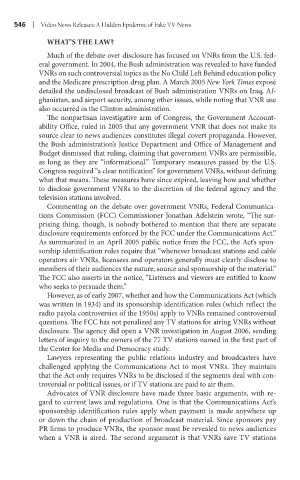Page 567 - Battleground The Media Volume 1 and 2
P. 567
| V deo News Releases: A H dden Ep dem c of Fake TV News
whaT’s ThE Law?
Much of the debate over disclosure has focused on VNRs from the U.S. fed-
eral government. In 2004, the Bush administration was revealed to have funded
VNRs on such controversial topics as the No Child Left Behind education policy
and the Medicare prescription drug plan. A March 2005 New York Times exposé
detailed the undisclosed broadcast of Bush administration VNRs on Iraq, Af-
ghanistan, and airport security, among other issues, while noting that VNR use
also occurred in the Clinton administration.
The nonpartisan investigative arm of Congress, the Government Account-
ability Office, ruled in 2005 that any government VNR that does not make its
source clear to news audiences constitutes illegal covert propaganda. However,
the Bush administration’s Justice Department and Office of Management and
Budget dismissed that ruling, claiming that government VNRs are permissible,
as long as they are “informational.” Temporary measures passed by the U.S.
Congress required “a clear notification” for government VNRs, without defining
what that means. These measures have since expired, leaving how and whether
to disclose government VNRs to the discretion of the federal agency and the
television stations involved.
Commenting on the debate over government VNRs, Federal Communica-
tions Commission (FCC) Commissioner Jonathan Adelstein wrote, “The sur-
prising thing, though, is nobody bothered to mention that there are separate
disclosure requirements enforced by the FCC under the Communications Act.”
As summarized in an April 2005 public notice from the FCC, the Act’s spon-
sorship identification rules require that “whenever broadcast stations and cable
operators air VNRs, licensees and operators generally must clearly disclose to
members of their audiences the nature, source and sponsorship of the material.”
The FCC also asserts in the notice, “Listeners and viewers are entitled to know
who seeks to persuade them.”
However, as of early 2007, whether and how the Communications Act (which
was written in 1934) and its sponsorship identification rules (which reflect the
radio payola controversies of the 1950s) apply to VNRs remained controversial
questions. The FCC has not penalized any TV stations for airing VNRs without
disclosure. The agency did open a VNR investigation in August 2006, sending
letters of inquiry to the owners of the 77 TV stations named in the first part of
the Center for Media and Democracy study.
Lawyers representing the public relations industry and broadcasters have
challenged applying the Communications Act to most VNRs. They maintain
that the Act only requires VNRs to be disclosed if the segments deal with con-
troversial or political issues, or if TV stations are paid to air them.
Advocates of VNR disclosure have made three basic arguments, with re-
gard to current laws and regulations. One is that the Communications Act’s
sponsorship identification rules apply when payment is made anywhere up
or down the chain of production of broadcast material. Since sponsors pay
PR firms to produce VNRs, the sponsor must be revealed to news audiences
when a VNR is aired. The second argument is that VNRs save TV stations

